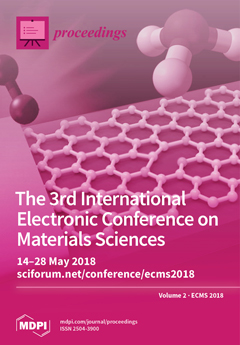Need Help?
Proceedings, 2018, ECMS 2018
The 3rd International Electronic Conference on Materials Sciences
Online | 14–28 May 2018
Issue Editors:
Maryam Tabrizian, McGill University, Canada
Dusan Losic, University of Adelaide, Australia
- Issues are regarded as officially published after their release is announced to the table of contents alert mailing list.
- You may sign up for e-mail alerts to receive table of contents of newly released issues.
- PDF is the official format for papers published in both, html and pdf forms. To view the papers in pdf format, click on the "PDF Full-text" link, and use the free Adobe Reader to open them.
Cover Story (view full-size image):
This Proceeding is a collection of selected papers from the 3rd International Electronic Conference on Materials (ECMS-2018).Throughout this event, we covered the following topics: Materials
[...] Read more.
This Proceeding is a collection of selected papers from the 3rd International Electronic Conference on Materials (ECMS-2018).Throughout this event, we covered the following topics: Materials Characterization; Nanotechnology in Material sciences and Engineering; Manufacturing Processes and Systems; Biomaterials; Fibers and Membranes; Optical, Electrical and Magnetic Materials.
Previous Issue
Next Issue
Issue View Metrics
Multiple requests from the same IP address are counted as one view.



